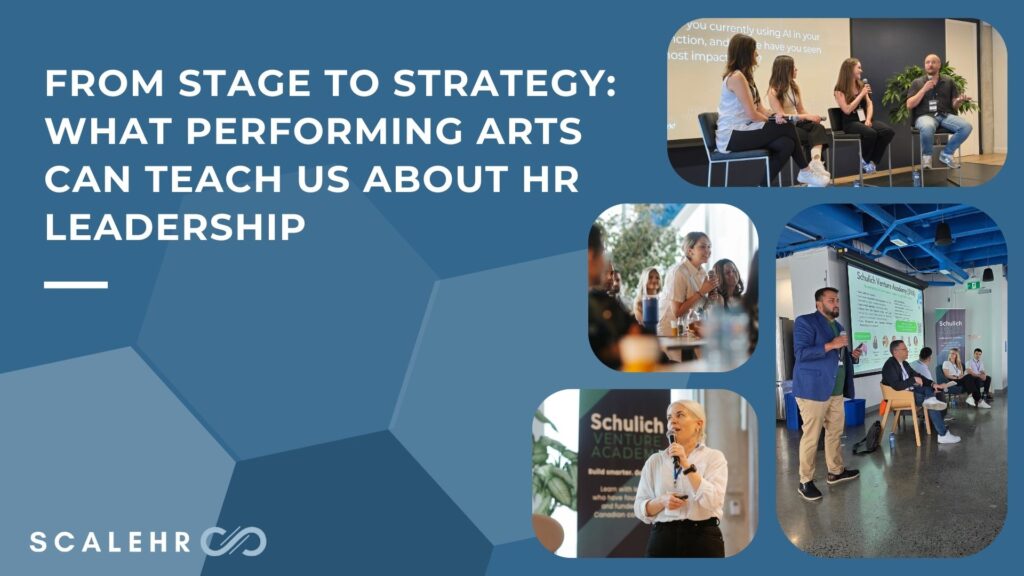In HR, we spend a lot of time talking about frameworks, compliance, and data, and rightly so. But leadership isn’t built on structure alone. It’s built on connection, communication, adaptability, and presence, all things honed not in the boardroom, but on the stage.
In today’s world of work, the line between business leadership and human storytelling is blurrier than ever. And if we want to lead with impact, we need to borrow a page from the playbook of performers.
Note: this blog post follows up on a recent Unmuted Podcast episode with Kate Ryan, Senior Manager – Employer Brand, DEIB & Internal Communications, a 1Password. View the episode below.
Leadership Is Performance – But Not the Way You Think
Let’s be clear: this isn’t about putting on an act. It’s about embracing the deeply human skills that artists use every day to create connection, express vulnerability, and adapt in real time.
People with a background in performing arts often enter the HR field with an edge they don’t even realize they have:
- They’re trained to read a room and respond accordingly.
- They’ve practiced active listening, not just hearing words, but understanding what’s underneath.
- They’re masters of presence, knowing how to command attention and hold space even in silence.
For HR leaders, these are superpowers. Because when you’re navigating complex interpersonal dynamics, driving culture change, or simply leading with authenticity, performance principles don’t just help. They transform.
The Power of Presence, Voice, and Improv in the HR Toolkit
One of the most transferable performance skills is presence: the ability to walk into a room and immediately shift the energy, even before speaking. In HR, presence means being grounded and intentional during tense conversations, or simply creating a sense of psychological safety.
Voice and breath control: things performers train for, also matter in HR. Whether you’re presenting to executives or delivering feedback in a one-on-one, tone, pace, and delivery shape how your message is received just as much as the words you choose.
And then there’s improv. The foundational rule of improv, “Yes, and…” teaches flexibility, open-mindedness, and collaboration. In HR, this mindset enables us to respond rather than react, and to move a conversation forward even when the outcome is uncertain.
Improv is especially powerful in change management, where leaders must hold ambiguity, meet resistance, and co-create paths forward in real time.
Why Storytelling Is Your Secret Weapon
Ask any performer what moves an audience, and they’ll tell you: story. Storytelling helps people feel something, remember something, and see themselves in the message. That’s exactly what HR leaders need when:
- Driving cultural transformation
- Rolling out new programs
- Gaining buy-in from skeptical teams
- Onboarding new employees
While data helps you prove a point, stories help people believe it. When leaders share real moments of growth or vulnerability, it humanizes them. When HR shares employee voices instead of brand slogans, culture becomes real. When you’re trying to influence behaviour, storytelling builds the emotional bridge people need to walk across.
Bringing Performing Arts into HR Practice (No Stage Required)
You don’t have to be a trained actor to benefit from performance tools. Here are a few accessible ways to start:
- Host an improv session with your team. It’s a playful, low-stakes way to build trust, improve communication, and practice adaptability.
- Use journaling or storytelling prompts in leadership training. Invite team members to reflect on their values, defining moments, or “fail forward” stories.
- Practice presence by creating space before important conversations: a breath, a pause, an intention.
- Get curious about how you show up. How’s your body language? Your tone? What are you performing, and is it aligned with what you want to convey?
The point isn’t to perform more. It’s to perform more humanely with intention, empathy, and creativity.
The Big Takeaway
Leadership isn’t just strategy; it’s storytelling, presence, improvisation, and connection.
Or in other words: leadership is performance.
When HR leaders embrace this truth, they unlock a new level of impact. They build cultures rooted in authenticity. They inspire trust. They navigate change with grace. And they show their teams that leadership isn’t about having all the answers. It’s about showing up, fully and humanly, in every moment that matters.
So the next time you walk into a room, step into that meeting, or kick off a tough conversation, take a breath.
You’re not just leading.
You’re performing the most important role there is: helping humans thrive at work.








